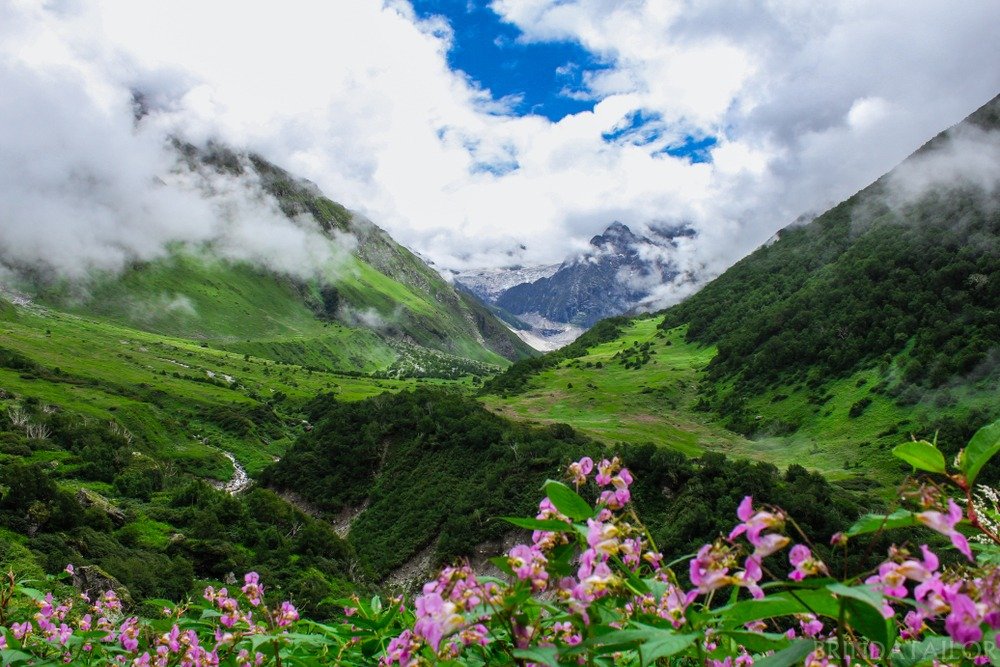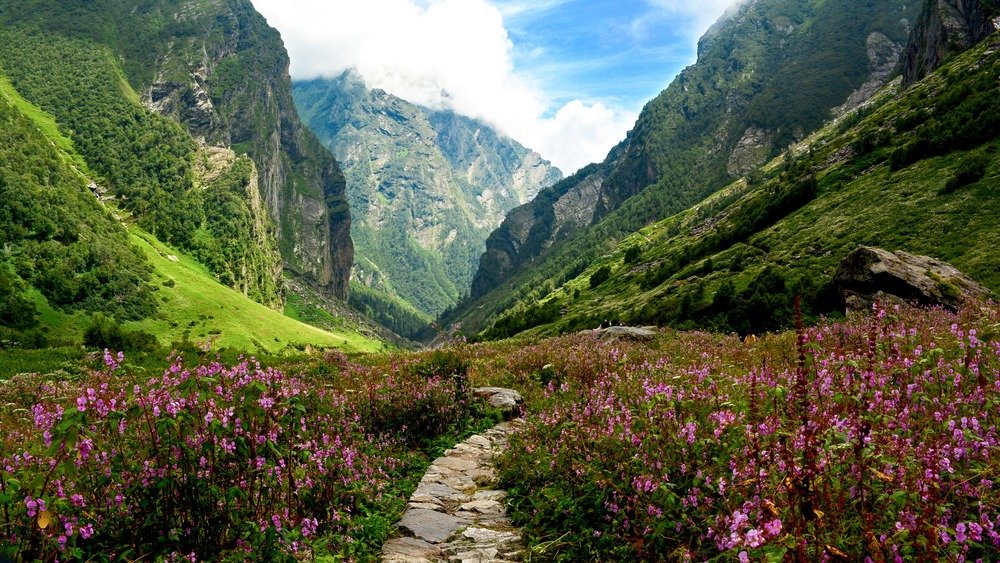The Valley of Flowers Trek in Uttarakhand, India, is nothing short of a marvel. With its picturesque landscapes, vibrant meadows, and rare species of flora and fauna, this trek has earned its place as one of the most beautiful treks in the world. As someone who has experienced its charm firsthand, I’m here to guide you step by step through everything you need to know to make your own journey unforgettable. From preparation to the final ascent, this guide will ensure you’re ready for the adventure of a lifetime.
1. Why the Valley of Flowers Trek Should Be on Your Bucket List
When people ask me why I chose the Valley of Flowers as my next trekking destination, my answer is simple: it’s one of those rare places where nature truly shows off. The valley, nestled in the heart of the Himalayas, is home to an overwhelming array of wildflowers, some of which are so rare that they can only be found in this region. It’s not just a trek; it’s a spiritual experience.
The Valley of Flowers is a UNESCO World Heritage site, and for good reason. The landscape changes with the seasons, and when you visit in the peak blooming months from July to September, you’re greeted with a riot of colors. It’s as though the earth itself has painted the canvas of the valley with every shade imaginable. Whether you’re a photographer, a botanist, or simply someone who loves nature, the sight of these blooming flowers will leave you in awe. And beyond the flowers, the surrounding mountains, crystal-clear rivers, and the cool Himalayan air make this trek one you’ll remember forever.
The Valley of Flowers isn’t just about the flora; it’s also about the energy of the place. It’s a peaceful, almost magical location that connects you with nature in a way few places can. Trekking here isn’t just about reaching the end goal; it’s about taking in every moment along the way—each breath of mountain air, each view of snow-capped peaks, and each step on the flower-covered ground.
2. Preparing for the Adventure of a Lifetime

If you’re thinking of taking on the Valley of Flowers Trek, one thing is for certain: preparation is key. This trek is not the most difficult one out there, but it requires a reasonable level of physical fitness and mental readiness. The altitude and the terrain are factors that can affect even seasoned trekkers, so it’s best to come prepared.
Physical Preparation: Get Your Body Ready for the Challenge
The trek itself is moderate in difficulty, with a few challenging sections, especially when climbing uphill toward Ghangaria and the Valley of Flowers. The altitude doesn’t hit you immediately, but once you reach higher points, it can make even simple tasks feel more difficult. To ensure that you’re physically prepared for the trek, focus on endurance and strength training.
Before my trek, I followed a routine that focused on cardio (like cycling and hiking), strengthening exercises for my legs, and stamina workouts such as running or swimming. A couple of months before the trip, I would go on weekend hikes, gradually increasing the distance and carrying a light backpack to simulate the conditions of the trek. This helped me adapt to the change in altitude and the long durations of walking.
Also, don’t forget your legs—they’ll do most of the work on this trek. Squats, lunges, and calf raises were a must for me to build strength in my legs and prepare for the steep ascents, especially as I climbed from Govindghat to Ghangaria.
Mental Preparation: Embrace the Challenge
Physical fitness is only part of the preparation for this trek; mental readiness is just as important. As you ascend, there will be times when you feel like giving up—whether it’s due to exhaustion or the relentless uphill climb. During these moments, it’s important to stay focused and keep pushing yourself. I found that breaking the trek into manageable segments helped. Instead of thinking of the whole day’s trek, I would focus on getting to the next milestone, like the next stream or rest stop.
It also helps to be mentally prepared for the unpredictable weather. The valley’s weather can change rapidly. One minute it can be sunny, and the next minute, it might start raining heavily. Be prepared for such changes by packing appropriate gear like rain jackets and waterproof clothing. It’s important to embrace the unpredictability because that’s part of the adventure.
3. The Journey Begins: Reaching Govindghat
Govindghat is where the trek officially begins, but getting there is an adventure in itself. Situated 20 kilometers from Joshimath, it’s the first stop for most trekkers and provides the perfect introduction to the trek. Govindghat is a small town on the banks of the Alaknanda River, surrounded by stunning mountain views.
Getting There: The Road to Adventure
Reaching Govindghat itself is a journey worth noting. I took a private vehicle from Rishikesh, which took about 10 hours, but the drive was filled with scenic views of winding mountain roads, waterfalls, and green valleys. If you’re a nature lover, you’ll enjoy every second of the drive. The road itself is narrow in places, but it offers magnificent views of the Himalayan peaks.
There are also buses available from Haridwar and Dehradun to Joshimath, and from there, a short ride takes you to Govindghat. You may also find taxis and shared jeeps to get to your destination. Govindghat feels like a quaint little mountain town, and once you arrive, you’ll notice trekkers and locals alike preparing for the same journey. It’s easy to get swept up in the excitement, knowing that your adventure is about to begin.
Where to Stay in Govindghat
Govindghat offers basic accommodations, mostly guesthouses, small hotels, and lodges that cater specifically to trekkers. Many of these establishments provide warm food, which is essential to keep your energy levels up before starting the trek. I stayed in a guesthouse that had comfortable rooms with simple amenities like warm blankets and hot water, perfect for the night before the big climb. The atmosphere was friendly, and I had the chance to meet fellow trekkers who shared tips and stories about their trekking experiences.
4. Onward to Ghangaria: The Real Trek Starts Here
After getting some rest, it’s time to hit the trail. The 13-kilometer trek to Ghangaria is relatively moderate but will take around 6-7 hours to complete. Ghangaria serves as the last village before the Valley of Flowers, and although it’s a small settlement, it’s the perfect base camp for trekkers.
What to Expect Along the Way: A Forest of Wonder
The journey to Ghangaria is a delight for nature lovers. As I hiked, I was surrounded by forests of oak, rhododendron, and pine trees, with a backdrop of towering peaks. The air is crisp, and the atmosphere is peaceful, with the sound of birds and the gentle rustle of leaves guiding you along the trail. The path is mostly a well-maintained dirt road, but in some parts, it’s a rocky trail that requires careful footing.
Along the way, I crossed over wooden bridges and saw small waterfalls cascading down the mountainside. The river below was clear and fast-flowing, and the views of the surrounding mountains, still capped with snow, were breathtaking. If you’re lucky, you might spot some local wildlife, such as the Himalayan Monal, a colorful bird that’s often seen in these forests.
Reaching Ghangaria: A Rest Stop for the Night
Ghangaria, though small, has a few guesthouses and basic accommodations. After a long day’s trek, I was relieved to arrive at the village and find a comfortable place to rest. Ghangaria is at a higher altitude, so it’s also important to take some time to acclimatize and drink plenty of water. Many trekkers choose to stay here overnight to rest and get ready for the final climb to the Valley of Flowers the next day.
5. The Grand Finale: Trekking to the Valley of Flowers
After a good night’s sleep, the excitement hit—today, I would reach the Valley of Flowers, and I could feel my heart racing with anticipation. The final stretch from Ghangaria to the Valley is relatively short—about 3 kilometers—but it’s still a tough climb, and the altitude starts to make itself felt. The good news is, this stretch is totally worth the effort.
The Final Push: A Steady Ascent to Paradise
The trek to the Valley of Flowers is steep, and the thin mountain air can make it challenging, but the views make every step worth it. The path is relatively narrow, winding through the hills with alpine meadows on either side. The climb was tiring, but every time I paused to catch my breath, I was greeted with an even more spectacular view than before. As you approach the entrance to the Valley, the first sign of flowers will appear, and from that moment on, it only gets more beautiful.
Stepping into the Valley: Nature’s Masterpiece
When you step into the Valley of Flowers, you can’t help but feel like you’ve entered another world. The vast meadows are blanketed with an array of wildflowers—Blue Poppies, Primulas, and even Brahma Kamals (a sacred flower of the Himalayas). The landscape is like nothing I’ve seen before—like a painting brought to life. The vibrant colors, the cool breeze, and the snow-capped peaks in the background created a scene so peaceful that I spent hours walking and soaking in the beauty.
As you wander through the valley, keep an eye out for the local fauna. You might be lucky enough to spot a Himalayan Musk Deer or Snow Leopard. The Valley is also home to a wide range of birds and insects, making it a perfect location for wildlife lovers. Make your dream to the Valley of Flowers Trek come true with The Searching Souls. We provide well-planned itineraries, comfortable accommodations, and experienced guides to ensure you have the adventure of a lifetime.
Conclusion: A Trek to Remember
The Valley of Flowers Trek is an experience that has stayed with me long after I’ve returned home. It’s not just a physical journey, but a mental and spiritual one as well. Every step through the valley is a reminder of how beautiful and precious our natural world is. Whether you’re a seasoned trekker or a beginner, this trek offers something for everyone. If you’re ready for an adventure that combines physical challenge with nature’s beauty, then this trek should be at the top of your list.
FAQs
1. How difficult is the Valley of Flowers trek?
The trek is moderate in difficulty, with some steep sections, but it’s manageable for trekkers with basic fitness. Regular practice and endurance training will ensure you’re well-prepared.
2. Can beginners do this trek?
Yes, beginners can do the trek, but preparation is key. It’s important to gradually build up your stamina before the trip to ensure you’re ready for the climb.
3. When is the best time to visit the Valley of Flowers?
The best time to visit is during the monsoon season, specifically mid-July to September. During this time, the flowers are in full bloom, and the weather is favorable for trekking.
4. What should I pack for the trek?
Pack light but make sure to bring essential items like trekking shoes, rain gear, warm clothing, water bottles, snacks, and a camera to capture the memories.
5. Do I need a guide for the trek?
Although the trail is well-marked, hiring a guide can enrich the experience, as they provide valuable insights into the local flora, fauna, and culture.



